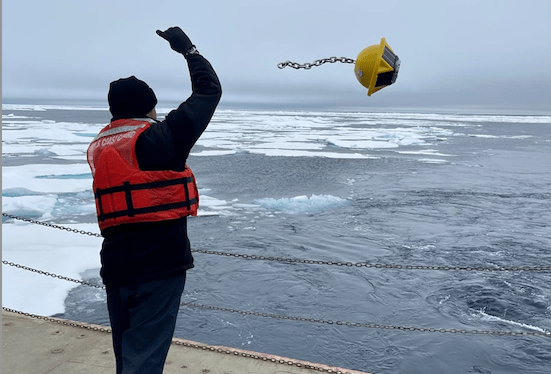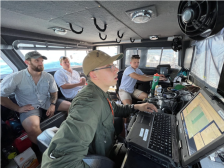Navy gaining access to global network of data-collecting buoys via new CRADA

Naval Meteorology and Oceanography Command (CNMOC) is poised to reinforce and expand its hub of critical marine and weather data collection and prediction assets via a new five-year cooperative research-and-development agreement (CRADA) with technology startup Sofar Ocean, DefenseScoop has learned.
This new agreement builds on years of engagement between the organizations and other Defense Department components like the Defense Advanced Research Projects Agency (DARPA) and Naval Research Laboratory.
Broadly, Sofar deploys a global network of marine weather sensors — called Spotter buoys — that captures thousands of so-called “ground truth” observations in the sea domain daily. The San Francisco-based company assimilates these various real-world observations of wave spectra, wind, sea surface temperature and barometric pressure into operational forecasts, which make up the foundation of its maritime capabilities for voyage optimization, extreme weather monitoring, and other offerings.
“The ocean environment is vastly under-sampled as compared to the atmosphere, and it’s [a] CNMOC mission to characterize this battlespace for the Navy. As such, Naval Oceanography is always looking for ways to expand our ocean sensing capability in the most efficient and cost effective way,” Lea Locke-Wynn, undersea warfare technical lead in the command’s Future Capabilities Directorate, told DefenseScoop in an email on Tuesday.
Headquartered at NASA’s Stennis Space Center in Mississippi, CNMOC is the Naval Oceanography Program’s operational arm. The command captures and processes data about the environment that informs military decision-making across many disciplines — including for anti-submarine and mine warfare, fleet and aviation operations, navigation, astrometry, and intelligence, surveillance and reconnaissance activities.
In response to questions from DefenseScoop, Locke-Wynn — a scientist with particular expertise in the physical oceanography of the Western Pacific — discussed multiple “unique aspects” to the company’s capability that appeal to CNMOC.
“The first is that Sofar’s Spotter buoy network offers an existing solution to observations at scale in the marine environment and is a substantial, complementary dataset to the Navy’s existing organic environmental collection capability,” she said.
Another is Sofar’s Smart Mooring technology, which provides “a real-time understanding of wave and current velocity conditions in nearshore regions,” according to Locke-Wynn. The system can be deployed quickly and enable real-time access to a data-stream from below the waters’ surface that can support observationally backed recommendations for diver or uncrewed platform operations.
“The lightweight aspect of the Smart Mooring is very attractive as an operational solution because it can be deployed quickly with very minimal manpower and additional equipment and allows for rapid decision-making. Additionally, Sofar utilizes an open-source standardized hardware interface — Bristlemouth — making both Spotter and Smart Mooring capabilities easily tailorable to Navy-specific applications through the integration of various payloads/sensors,” Locke-Wynn told DefenseScoop.
For her team, “the short-term focus of our collaboration is utilizing Sofar’s hardware and sophisticated interfaces to demonstrate improved decision-making at the tactical edge,” she said.
In the long term, the Navy intends for this partnership to strengthen its advanced modeling assets.
“Ultimately, CNMOC would like to see the globally distributed observational dataset collected by Sofar utilized by the Navy’s operational numerical modeling capability to improve the resulting oceanographic and atmospheric forecasts that support a wide swath of Fleet applications,” Locke-Wynn said.
The command “anticipates significant improvement specifically to its operational ocean circulation prediction as well as wave prediction capabilities, and possibly others, resulting from the inclusion of the Sofar data-stream,” she noted.
More skillful prediction of how the ocean circulates could bolster the Navy’s ability to characterize the environment to inform conflict missions, force protection decisions and search-and-rescue application.
However, many of the advancements needed for Naval Oceanography to fully capitalize on Sofar’s observational network in its operational numerical models are still in the research and development phase under the Naval Research Laboratory and are three to five years from being operational, Locke-Wynn added, pointing back to that long-term focus.
This new CRADA was a direct output of efforts the command engaged in with DARPA in 2022, “to understand, and eventually transition, the work that was accomplished under their Ocean of Things (OoT) initiative, where Sofar was a sub-contractor,” she also confirmed.
Through the Ocean of Things effort, DARPA essentially oversaw the deployment of thousands of small, low-cost platforms to form a distributed sensor network that could underpin persistent maritime situational awareness over vast ocean space.
CNMOC’s subordinate command — the Naval Ice Center — also partnered with Sofar last summer under a special-purpose CRADA, to deploy five Spotter buoys in the historically data-sparse Arctic region to capture metocean observations, during U.S. Coast Guard cutter Healy’s deployment to the North Pole.
“This was a very successful venture and demonstrated the robustness of the Spotter as a platform capable of surviving in the harsh Arctic environment,” Locke-Wynn said.
More recently, Sofar and CNMOC hosted an event on July 17 and 18 at Stennis Space Center to officially launch their new agreement and strategic partnership. Officials from both organizations facilitated discussions and presentations, while participants from other Navy components also weighed in.
There, command and Sofar officials ultimately agreed upon three primary capability areas to prioritize for collaboration: hardware for ocean data collection, data assimilation, as well as data-as-a-service (DaaS) and data management.
As a result of that initial technical exchange meeting, Locke-Wynn said, “CNMOC will pursue exercising deployment and usage of Sofar’s data collection to improve forecasting decisions for several operational use cases.”
“Future discussions are being planned under the CRADA regarding [concept of operations] development and lessons learned from our hands-on applications meant to further our partnership and advance Sofar’s technology for Navy’s operational use,” she also told DefenseScoop.






